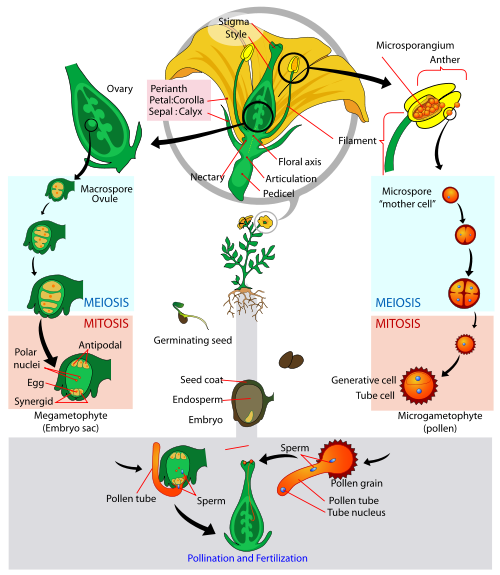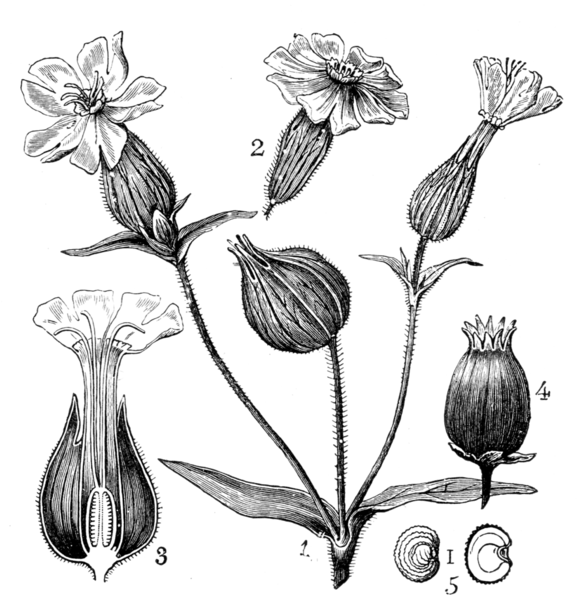Reproduction
 Silene
latifolia is an angiosperm which means that it is a
flowering plant. Reproduction of S. latifolia, as with most
plants, follows the alternation of generations lifecycle. The
alternation of generations alternates between
a
diploid sporophyte generation and a haploid gametophyte
generation. Reproduction starts with a diploid sporophyte
generation. The plant that is seen is the multicellular
sporophyte.
Silene
latifolia is an angiosperm which means that it is a
flowering plant. Reproduction of S. latifolia, as with most
plants, follows the alternation of generations lifecycle. The
alternation of generations alternates between
a
diploid sporophyte generation and a haploid gametophyte
generation. Reproduction starts with a diploid sporophyte
generation. The plant that is seen is the multicellular
sporophyte.
Inside of the male flowers are anthers which contain microsporocytes. The microspores undergo meiosis which creates haploid spores. The microspore undergoes mitosis and becomes a pollen grain. The pollen grain is also known as the male gametophyte.
In the female flowers, meiosis occurs in the ovule and megaspores are produced. The megaspore divides by mitosis to become the female gametophyte. The pollen grain pollinates the female flower by landing on the stigma of the female. The sperm from the pollen grain fertilize the egg to form a zygote and the polar nuclei of the female gametophyte which is known as double fertilization. The zygote develops into an embryo which later grows into the sporophyte. When the sporophyte is fully mature, the life cycle begins again (Campbell, et al., 2008). To learn about another plant that has an alternation of generations life cycle, check out Linum marginale, wild flax!
 Reproduction
of Silene latifolia mainly occurs through
seeds. Silene latifolia has extremely high
reproductive rates because they can produce hundreds of seeds
during one reproductive season. A single plant can produce about
50 capsules, each capsule containing an average of 500 seeds.
These seeds are then dispersed (OARDC, n.d).
Producing such high numbers of seeds is very advantageous to the
survival strategies of this species. The high number of seeds
allows for increased rate of reproduction and ensures that some
offspring of the plant will survive.
Reproduction
of Silene latifolia mainly occurs through
seeds. Silene latifolia has extremely high
reproductive rates because they can produce hundreds of seeds
during one reproductive season. A single plant can produce about
50 capsules, each capsule containing an average of 500 seeds.
These seeds are then dispersed (OARDC, n.d).
Producing such high numbers of seeds is very advantageous to the
survival strategies of this species. The high number of seeds
allows for increased rate of reproduction and ensures that some
offspring of the plant will survive.

Silene latifolia is unique compared to other angiosperms
because it displays sexual dimorphism. Sexual dimorphism means
that there is a difference between the male and females of the
species. Male and female flowers are found on separate plants.
The image on the right shows a female flower (number 3) and male
flower (number 2). The female flowers are larger than male
flowers, however male flowers have more flowers open at a time
than female flowers do (Young, 2002). The flowers are open in
the evening and stay open until midmorning which allows for
pollination during the night and during the day as well. Most
pollination occurs at night and is done by moths. To help
increase chances of pollination, Silene latifolia has a
strong scent to attract nocturnal pollinators (Dötterl,
et. al, 2005). To learn more about moths that
are nocturnal pollinators,
check out the
Hemaris thysby, the Hummingbird Clearwing moth.
Besides nocturnal pollination, the flowers are open for a few hours
during the day so bees and other insects are also minor
contributors to pollination (Young,
2002).